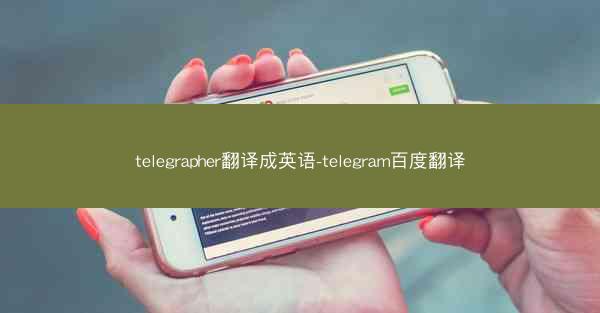telegrapher翻译成英语-telegram百度翻译

Telegrapher: The Unseen Hero of the Information Age
In the bustling era of the digital revolution, the term telegrapher might evoke images of a bygone era, but its legacy is as powerful and relevant today as it was in the 19th century. The translation of telegrapher into English, telegram, reveals a fascinating journey through the annals of communication history.
The Birth of the Telegram: A Leap into the Future
Imagine a world where messages could travel faster than the speed of a horse. The telegraph, invented by Samuel Morse in the 1830s, was the first practical long-distance communication system. The term telegrapher refers to the operators who sent and received these messages, bridging the gap between people separated by vast distances. The translation of telegrapher into English, telegram, marked the beginning of a new era, one where information could be transmitted instantaneously.
The Art of the Telegram: A Window into the Past
Telegrams were not just a means of communication; they were a form of art. The telegrapher's skill lay in their ability to translate spoken words into a series of dots and dashes, known as Morse code. This intricate dance of signals was the language of the telegrapher, a language that required precision and speed. The translation of telegrapher into English, telegram, became a symbol of efficiency and reliability.
The Evolution of the Telegram: From Wire to Wireless
As technology advanced, the telegrapher's role evolved. The advent of wireless telegraphy in the late 19th century introduced a new dimension to communication. Operators now had the ability to send and receive messages without the need for physical wires. The translation of telegrapher into English, telegram, took on a new meaning, reflecting the transition from a traditional to a modern form of communication.
The Legacy of the Telegram: A Time Capsule of History
Today, the telegram might seem like a relic of the past, but its impact is undeniable. The translation of telegrapher into English, telegram, represents a time capsule, capturing the essence of a period when every message carried the weight of urgency. These telegrams, preserved in archives and collections, offer a glimpse into the lives of people from a bygone era, revealing the stories that shaped history.
The Resurgence of the Telegram: A Modern Renaissance
In an age dominated by emails and instant messaging, the telegram has found a new lease on life. The translation of telegrapher into English, telegram, has been reimagined as a service that offers a sense of formality and elegance. Modern telegrams, often used for special occasions, have become a symbol of nostalgia and tradition, bridging the gap between the past and the present.
The Future of the Telegram: A New Chapter
As technology continues to evolve, the role of the telegrapher, or the modern-day equivalent, may change once again. The translation of telegrapher into English, telegram, will undoubtedly adapt to the digital age, perhaps taking on new forms and functions. The legacy of the telegrapher, however, will remain, a testament to the enduring power of communication and the human desire to connect.
In conclusion, the translation of telegrapher into English, telegram, is more than just a linguistic exercise; it is a story of human ingenuity and the relentless pursuit of progress. The telegrapher, a silent hero of the information age, has left an indelible mark on history, and the legacy of the telegram continues to resonate in the digital world we inhabit today.










